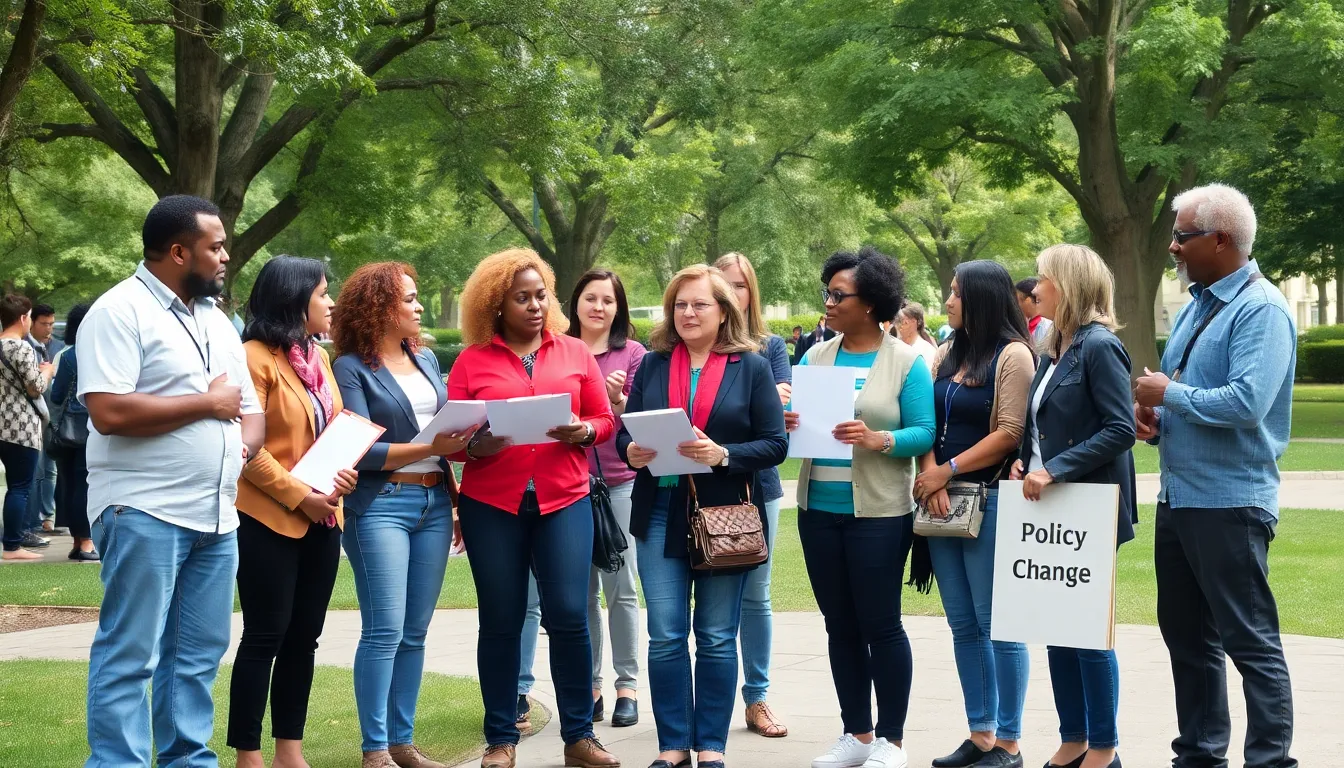In a world where policies can make or break communities, policy advocacy is the superhero we didn’t know we needed. Think of it as the ultimate game of chess where every move counts and the stakes are high. Advocates don’t just play the game; they change it, ensuring that the voices of the many drown out the whispers of the few.
Table of Contents
ToggleUnderstanding Policy Advocacy
Policy advocacy plays a vital role in influencing legislative decisions and shaping community needs. Advocates push for changes that impact society significantly.
Definition of Policy Advocacy
Policy advocacy refers to organized efforts aimed at influencing public policy. It involves promoting specific issues and mobilizing stakeholders to push for change. Advocates often engage with lawmakers, providing research and evidence to support their positions. Grassroots movements, coalitions, and interest groups frequently collaborate in these efforts. Achieving meaningful policy change demands clear communication and strategic planning by advocates.
Importance of Policy Advocacy
Policy advocacy drives social change and addresses community issues effectively. It raises awareness on critical topics, ensuring the voices of marginalized groups are heard. Participation in advocacy fosters civic engagement and strengthens democracy. Successful advocacy efforts contribute to legislation that meets community needs. By highlighting the importance of community input, advocates play a crucial role in shaping effective policies. Data shows that well-organized advocacy can lead to increased funding for public programs.
Key Components of Effective Policy Advocacy

Effective policy advocacy relies on several essential elements. Research and evidence gathering significantly enhances advocacy efforts.
Research and Evidence Gathering
Accurate data forms the backbone of persuasive advocacy. Results from studies often support claims and strengthen positions. Gathering qualitative and quantitative evidence helps advocates make informed arguments. Inviting experts to share insights through reports and testimonies enriches discussions. Presenting robust statistics can sway public opinion and lawmakers alike. Utilizing credible sources adds weight to proposals, ensuring they resonate with stakeholders.
Coalition Building
Collaboration amplifies advocacy impact. Engaging diverse groups fosters unified voices in support of shared goals. Building coalitions involves identifying potential allies and uniting various stakeholders. Connecting with community organizations, businesses, and other interest groups creates a broader support base. Establishing mutual trust solidifies partnerships that endure and thrive. Together, coalitions can mobilize resources and coordinate efforts, increasing their visibility and effectiveness.
Strategies for Successful Policy Advocacy
Effective policy advocacy hinges on specific strategies that can drive impactful change in communities. Key strategies include grassroots mobilization and engaging with policymakers.
Grassroots Mobilization
Grassroots mobilization empowers community members to participate in advocacy efforts. Organizing local events and workshops fosters relationships among advocates and community members. Training sessions on advocacy skills equip individuals with the knowledge they need to raise their awareness. Utilizing social media efficiently amplifies messages and connects supporters rapidly. Campaigns tailored to local issues create a sense of ownership among participants. Mobilizing citizens not only increases visibility but also builds a strong, unified front that influences decision-makers effectively.
Engaging with Policymakers
Engaging with policymakers requires a strategic approach to communication. Understanding the interests and priorities of legislators helps tailor discussions effectively. Crafting clear and concise messages facilitates productive dialogue about specific issues. Presenting well-researched evidence strengthens arguments and highlights the urgency of policy needs. Scheduling meetings with legislators opens opportunities for face-to-face conversations and relationships. Leveraging testimonies from affected individuals adds a personal touch to advocacy efforts, fostering empathy and connection. By ensuring transparency and accessibility, advocates can create lasting relationships that bolster their influence on policy decisions.
Challenges in Policy Advocacy
Policy advocacy faces several challenges that can hinder effective efforts. Understanding these challenges allows advocates to adapt their strategies accordingly.
Common Barriers
Limited funding often restricts advocacy’s reach. Stakeholders may lack adequate resources to support campaigns. Additionally, political resistance can obstruct proposed changes, particularly in polarized environments. Miscommunication among advocacy groups may lead to fragmented messages, weakening the overall impact. Misinformation spreading among the public can create confusion, diminishing trust in advocates’ motives.
Overcoming Obstacles
Advocates can counter funding issues through diverse fundraising approaches. Engaging local businesses for support can enhance resources. Building strong coalitions improves public visibility, uniting various organizations around common goals. Utilizing clear and consistent communication strengthens messages, allowing for more effective outreach. Educating the public through workshops and informational campaigns combats misinformation, fostering a better understanding of advocacy objectives.
Policy advocacy stands as a powerful tool for driving social change and addressing community needs. By leveraging research and building coalitions advocates can effectively influence decision-makers and amplify the voices of those often overlooked. The challenges faced in this arena are significant but not insurmountable. Through strategic communication grassroots mobilization and education advocates can navigate these hurdles and foster a more informed and engaged public. As communities continue to evolve so too must the strategies employed in advocacy efforts ensuring that the push for meaningful change remains strong and impactful.




